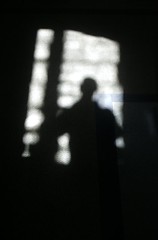From behind 1.89
Our local museum, as part of its recent 'Century of American Art' exhibition, commissioned a famous conceptual artist to create a large-scale work that would illustrate the state, in her opinion, of American at century's end. The artist accepted, and began what she claimed would be a full year of research and contemplation of the work.
Meanwhile, the museum set to the tasks of choosing works from its own collection and requesting loans of seminal works from other museums around the country. A month before the exhibition was to open, the museum closed its doors entirely and renovated all its galleries. Curators prepared essays and tour booklets and hired docents to lead museumgoers through the show. Advertisements were placed which stressed the importance of the conceptual artist and her mysterious fin-de-siecle masterwork.
With a couple of weeks left before the opening of the exhibition, preparators began to hang the works in their respective galleries. The gallery devoted to the conceptual artist, however, remained empty, and she made no appearance at the museum. Curators, fearing she was ill or had (as she was known occasionally to do) suffered a nervous breakdown, left repeated messages on her answering machine. When she didn't respond the curators visited her studio. She was never in. One scant week before the opening, the curators received a call from a lawyer representing the conceptual artist. He arranged a meeting with museum officials, during which he revealed that the artist would not install her great work unless a new contract was drawn up and new obligations fulfilled. These included a promise of certain foods at the opening party, a number of unusual and expensive material gifts, a poem composed in her honor to be read at an unveiling ceremony, and a substantial increase in the amount of her commission. While the museum did not wish to cave in to her demands, they nonetheless recognized the importance of her piece to their exhibition, and swallowed their pride.
On the day before the show was to open, the conceptual artist walked into the gallery reserved for her, and thumbtacked to its far wall signed and executed copies of her original contract, her new contract, and a large color photograph of her lawyer. Then she set a metal salad bowl on the floor, fillied it with twenty-dollar bills in the amount of her 'raise' and burned them to ashes.
The piece drew thousands of eager museumgoers who had read about the contractual haggling and wanted to see what the fuss had been about. Reactions were strong but mixed. Some said the piece confirmed their opinion that contemporary art was an elaborate scam designed to part pretentious fools from their money. Others claimed the piece confirmed their opinion that contemporary art was once vital and incisive, but had since 'sold out' to commercial interests. This latter group divided into two camps; those who believed that the new work was a perfect example of such a sellout, and those who believed that the new work was a brilliant condemnation of those who had sold out.
At any rate, when the exhibition closed, the museum bought the controversial piece for its permanent collection, paying an undisclosed sum far above and beyond the amount originally stipulated for the work's execution.
J.R. Lennon, "Conceptual" in Pieces for the Left Hand, 159-160.


0 Comments:
Post a Comment
<< Home